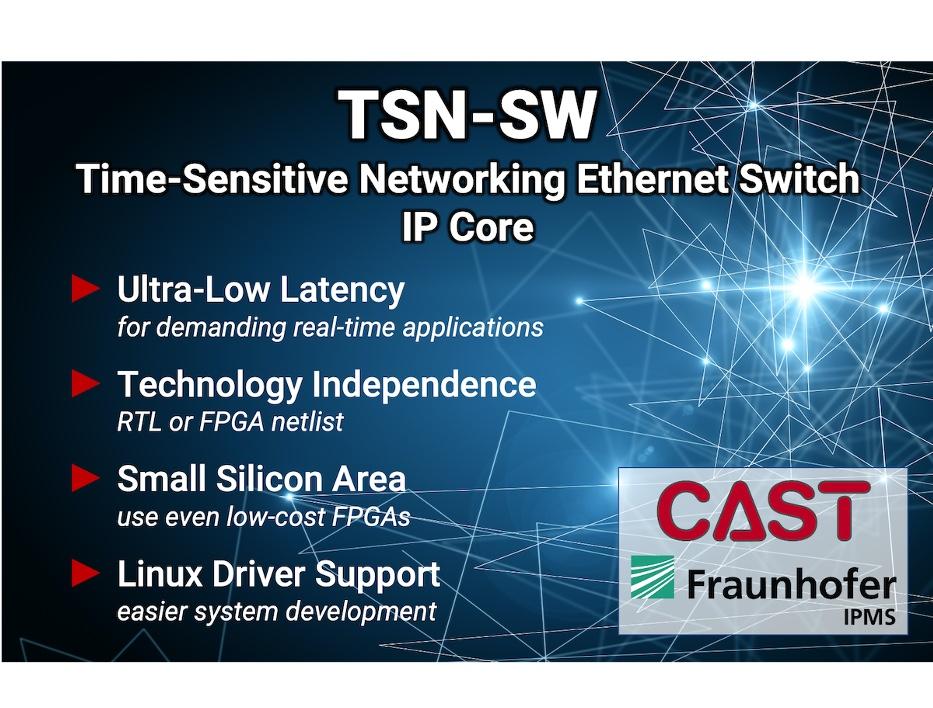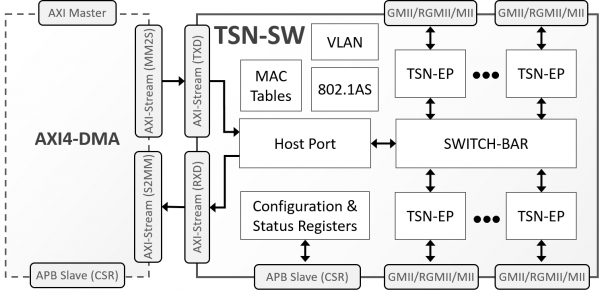Silicon IP Cores
TSN-SW
Multiport TSN Ethernet Switch
The TSN-SW implements a highly flexible, low-latency, multiport TSN Ethernet switch. It supports the hardware functionality for Ethernet bridging according to the IEEE 802.1Q standard and implements the essential TSN timing synchronization and traffic-shaping protocols (i.e. IEEE 802.1AS-2020, 802.1Qav, 802.1Qbv, and 802.1Qbu, 802.1br). Enhanced reliability features can also be supported, using the optional hardware modules for Frame Replication and Elimination for Reliability (IEEE 802.1CB) and Per-Stream Filtering and Policing (IEEE 802.1Qci). Featuring a configurable number of ports, the Layer-2 switch operates in cut-through mode at wire speed and can provide sub-microsecond port-to-port latency. The core is hence suitable for applications with demanding real-time requirements.
The TSN-SW operates efficiently under different usage scenarios and is highly configurable. Users can configure key factors via the core’s control registers: the mapping of VLAN priority levels to TSN traffic classes, the traffic scheduling and preemption parameters, the treatment of special frames (i.e. broadcast, unknown, & internal), as well as the VLAN ID and MAC lookup tables used for frame forwarding and filtering. The host system can also switch the mode of operation of each individual port from cut-through to store-and-forward to eliminate the propagation of bad frames at the cost of increased latency. The core otherwise operates autonomously and only requires software assistance at runtime for correct time synchronization; a lightweight ptp/802.1AS software stack comes with the core for that purpose.
The TSN-SW uses standard AMBA® interfaces to ease integration. Its control and status registers are accessible via a 32-bit-wide APB bus, and packet data can be exchanged with the host system via AXI-Streaming interfaces with 32-bit data buses. To further expedite and ease the implementation of customer applications, DMA engines providing access to the stream interfaces via a memory-mapped AXI4 master port, and software stacks supporting higher-layer protocols, such as IEEE 802.1Qcc, IEEE 802.1Qca and SNMP, are optionally available.
The TSN-SW is designed with industry best practices and is available in synthesizable RTL (Verilog 2001) source code or as a targeted FPGA netlist. Deliverables provide everything required for a successful implementation, including sample synthesis and simulation scripts, an extensive testbench, and comprehensive documentation.
Applications
The TSN-SW is suitable for implementing TSN Ethernet End-points in daisy-chained networks (e.g. ring topologies) requiring robust, low-latency, and deterministic communication. Such networks are used in automotive, industrial control, medical, and aerospace applications.
Support
The core as delivered is warranted against defects for ninety days from purchase. Thirty days of phone and email technical support are included, starting with the first interaction. Additional maintenance and support options are available.
Verification
The TSN-SW has been rigorously verified, hardware-validated and tested in real-life environments.
It has also been tested and verified at TSN interoperability plugfests organized by the Labs Network Industry 4.0 (LNI 4.0) association and the Industrial Internet Consortium (IIC).
Deliverables
The core includes everything required for successful implementation:
- Verilog RTL source code or targeted FFGA netlist
- Testbenches
- Sample Simulation and Synthesis scripts
- Comprehensive Documentation
- Lightweight PTP stack, easily portable to any other RTOS.
Reference FPGA designs with a freeRTOS example software stack with Command Line Interface can be made available on request.
TSN-SW can be mapped to any ASIC technology or FPGA device (provided sufficient silicon resources are available). Its silicon resource requirements depend on its configuration. The following are sample implementation results, for a few typical configurations for the core, mapped on a 22nm ASIC process (GF22FDX).
| Configuration | Logic Resources | Memory Resources | Clock Freq. (Mhz) |
|---|---|---|---|
| 4 Ports, 64 Lookup Entries 512 Ingress Mem 2 Traffic Classes 1k TC Queue Depth No Frame Preemption No CB and Qci |
82,066 um² 393,036 gates |
794K bits | 125 |
| 4 Ports, 128 Lookup Entries 512 Ingress Mem 4 Traffic Classes 1k TC Queue Depth Frame Preemption No CB and Qci |
130,236 um² 623,375 gates |
1,372K bits | 125 |
| 4 Ports, 512 Lookup Entries 512 Ingress Mem 8 Traffic Classes 1k TC Queue Depth Frame Preemption No CB and Qci |
159,326 um² 763,055 gates |
2000K bits | 125 |
Please contact CAST to get characterization data for your target configuration and technology.
The TSN-SW can be mapped to any Altera® FPGA device (provided sufficient silicon resources are available). The FPGA resources requirements depend on the core configuration. The following are sample results for a few typical configurations for the core. Please contact CAST to get characterization data for your target configuration and technology.
| Family/Device | Configuration* | ALMs | Memory (Mbits) |
|---|---|---|---|
| Cyclone V 5CSEBA6U19C6 |
4 Ports, 64 Lookup Entries 4kB Ingress Mem 8 Traffic Classes 1k TC Queue Depth No Frame Preemption |
17,692 | 0.83 |
| Cyclone V 5CSEBA6U19C6 |
4 Ports, 128 Lookup Entries 4kB Ingress Mem 8 Traffic Classes 1k TC Queue Depth Frame Preemption |
26,838 | 1.62 |
| Cyclone V 5CSEBA6U19C6 |
4 Ports, 512 Lookup Entries 4kB Ingress Mem 8 Traffic Classes 1k TC Queue Depth Frame Preemption |
33,306 | 2.60 |
*Partial list of configuration parameters
The TSN-SW can be mapped to any AMD FPGA device (provided sufficient silicon resources are available). The FPGA resources requirements depend on the core configuration. The following are sample results for a few typical configurations for the core. Please contact CAST to get characterization data for your target configuration and technology.
| Family/Device | Configuration* | Logic | Memory |
|---|---|---|---|
| Zynq UltraScale+ zu9eg-2-e |
128 Lookup Entries 2kB Ingress Mem 4 Traffic Classes 1k TC Queue Depth Frame Preemption |
41,999 LUTs | 65 RAMB36 28 RAMB18 |
| Kintex 7 7k160t-1 |
256 Lookup Entries 16kB Ingress Mem 4 Traffic Classes 1k TC Queue Depth No Frame Preemption |
42,650 LUTs | 65 RAMB36 28 RAMB18 |
| Kintex UltraScale ku115-2-i |
256 Lookup Entries 16kB Ingress Mem 8 Traffic Classes 1k TC Queue Depth No Frame Preemption |
42,330 LUTs | 65 RAMB36 28 RAMB18 |
| Kintex UltraScale+ ku15p-1-I |
128 Lookup Entries 2kB Ingress Mem 4 Traffic Classes 1k TC Queue Depth Frame Preemption |
42,330 LUTs | 65 RAMB36 17 RAMB18 |
*Partial list of configuration parameters
The TSN-SE can be mapped to any Lattice FPGA device (provided sufficient silicon resources are available). The FPGA resources requirements depend on the core configuration. The following are sample results for a few typical configurations for the core. Please contact CAST to get characterization data for your target configuration and technology.
| Family/Device | Configuration | Logic | Memory |
|---|---|---|---|
| CertusPro-NX LFCPNX-100 |
4 Ports, 64 Lookup Entries 512 Ingress Mem 2 Traffic Classes 1k TC Queue Depth No Frame Preemption |
32,765 LUT4 | 77 EBR |
| Certus-NX LFD2NX-40 |
4 Ports, 64 Lookup Entries 512 Ingress Mem 2 Traffic Classes 1k TC Queue Depth No Frame Preemption |
32,765 LUT4 | 77 EBR |
| CertusPro-NX LFCPNX-100 |
4 Ports, 512 Lookup Entries 512 Ingress Mem 8 Traffic Classes 1k TC Queue Depth Frame Preemption |
85,393 LUT4 | 197 EBR |
Engineered by Fraunhofer IPMS.

Features List
Low-Latency & Flexible Ethernet Switch
- Configurable number of 3 to 24 full-duplex Ethernet ports plus one internal port
- Low-latency cut-through or robust store-and-forward mode selectable per port
- Sub-microsecond port-to-port latency, in cut-through mode
- 10/100/1000 Mbps Ethernet speeds (10Gbps soon)
- 802.1Q Tagged VLAN support
- Port-based VLAN
- Configurable VLAN-PCP to TSN-queue mapping (QoS by PCP)
- Flexible VLAN and MAC forwarding & filtering
- Configurable VLAN-ID & MAC lookup table for dynamic and static entries
- Automatic aging table
- Untagged ports support
- Port Statistics
- Port Mirroring
TSN Features
- IEEE 802.1AS-2020 (requires lightweight software PTP stack)
- Traffic shaping per IEEE 802.1Qav & IEEE 802.1Qbv with eight TSN-Queues
- Frame preemption per IEEE 802.1Qbu and IEEE 802.3br
- Frame Replication and Elimination per IEEE 802.1CB and Per-Stream Filtering and Policing per IEEE 802.1Qci (optionally implemented in hardware)
- Path Control and Reservation per IEEE 802.1Qca, and Enhancements to Stream Reservation Protocol per EEE 802.1Qcc (optionally implemented in software)
Easy System Integration
- AMBA™/AXI4 SoC Interfaces
- 32-bit APB control/status interface
- 32-bit AXI4-Stream for packet data
- Optional AXI4 DMA engine
- MII, GMII or RGMII, and MDIO Ethernet PHY interface per port
- Requires minimal host assistance for initialization and operation
- Provides a wide range of statistics via optionally instantiated counters
- Complete FPGA reference designs available


